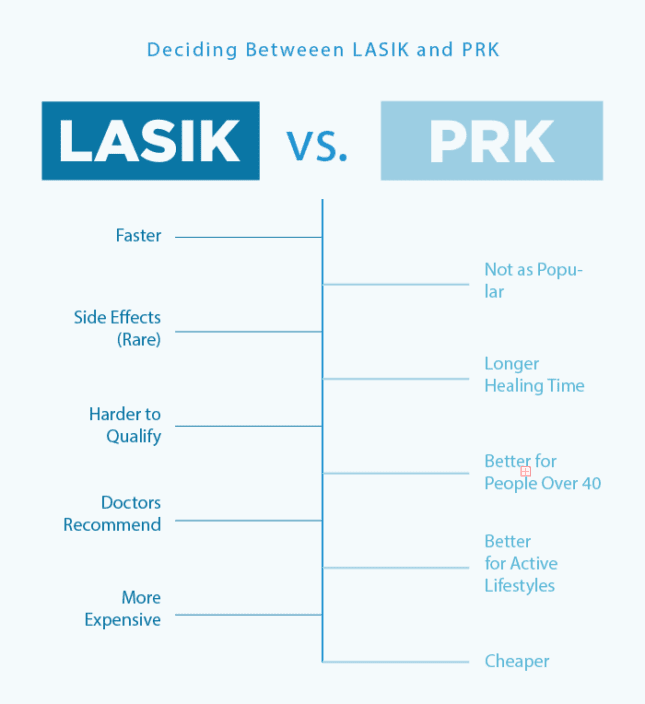
Medically Reviewed by Max Parikh, M.D.
PRK vs. LASIK: Which Laser Eye Procedure Is Best for You?
Last Updated:

Medically Reviewed by Max Parikh, M.D.
Photorefractive keratectomy (PRK) and laser-assisted in situ keratomileusis (LASIK) are surgical procedures to reshape your eye’s cornea and correct vision problems like nearsightedness, farsightedness, or astigmatism. While PRK requires a longer healing time, it can sometimes be a better operation for some people who may not qualify for LASIK.
Table of Contents
Key Facts About PRK & LASIK
- PRK and LASIK are both refractive surgeries in which doctors use lasers to reshape the eye and permanently correct common vision problems.
- PRK is the older surgery, as it was first performed in the 1980s. LASIK was developed in the 1990s and quickly became the preferred choice.
- People with thin corneas, steep corneas, or very athletic lifestyles might be better candidates for PRK instead of LASIK.
- LASIK is the most common type of refractive surgery used today. It’s used for several eye problems, causes little pain, and needs just a few days of recovery time.
- An eye doctor can tell you which option is right for you after a thorough examination and conversation about your lifestyle and vision goals.
PRK vs. LASIK: Understanding Both Procedures

PRK and LASIK target the cornea, reshaping it to ensure light focuses on the retina at the back of your eye. PRK and LASIK differ in how doctors expose deep corneal layers for surgery.
You deserve clear vision. We can help.
With 135+ locations and over 2.5 million procedures performed, our board-certified eye surgeons deliver results you can trust. Your journey to better vision starts here.
The U.S. Food and Drug Administration (FDA) approved PRK in 1996. Since then, technological advancements allowed surgeons to make even more precise adjustments to the eye’s shape and size. PRK surgery is approved for nearsightedness, farsightedness, and astigmatism.
LASIK was FDA approved in 1999, making it a newer surgery than PRK. Since then, newer lasers and measuring methods mean even more detailed adjustments and better outcomes. LASIK surgery is also approved for nearsightedness, farsightedness, and astigmatism.
What Happens During PRK Surgery?
If you’re approved for PRK surgery, you’ll come to an outpatient clinic for the procedure. The doctor will numb your eyes, use tools to keep them open, and get started.
Your surgeon removes tissue from the front of your eye with a laser or a brush. After the cornea is reshaped with an excimer laser and the doctor uses a bandage to protect the eye. Recovering from PRK surgery can take time, as your tissues must heal back together. But when your eyes have healed, you should see clearly.
What Happens During LASIK Surgery?
If you’re approved for LASIK, you’ll come to an outpatient clinic for the procedure. The doctor will numb your eyes, use tools to keep them open, and get started.
Your surgeon uses a microkeratome (small blade) or femtosecond laser to create a flap in your cornea. The cornea is reshaped with an excimer laser and the doctor puts the flap back over your eye.
Recovering from LASIK is quicker than PRK, as the flap works like a natural bandage. Most people are back to their normal routines in a few days.

What Are the Differences Between PRK & LASIK?
Your surgeon will tell you whether PRK or LASIK is right for your eyes, lifestyle, and vision goals. But doing your homework can help you be an informed participant in this important conversation. Here’s a quick look at some of the major differences between PRK and LASIK:
PRK
- It is an older and less complicated surgery than LASIK.
- Some doctors prefer PRK for patients as it requires less time and precision.
- Recovery time is longer and can sometimes be more painful than LASIK.
LASIK
- LASIK is a newer and slightly more complicated procedure due to the flap doctors create to expose corneal tissues.
- With advancements in LASIK, success rates are as high as 99% for achieving 20/20 vision post-procedure.
- The flap created during LASIK heals over time.
- However, thin corneas may not provide enough tissue for the flap and the correction, making LASIK unsuitable. In such cases, PRK could be a better choice.
This table includes more similarities and differences between PRK and LASIK:
Top PRK and LASIK Factors to Consider
| PRK | LASIK | |
| Conditions treated | Nearsightedness Farsightedness Astigmatism | Nearsightedness Farsightedness Astigmatism |
| Approved by the FDA? | Approved in 1996 | Approved in 1999 |
| Cost | $1,500–$3,000 per eye (on average) | $1,500–$3,000 per eye (on average) |
| Procedure duration | 10 minutes | 15 minutes |
| Pain during procedure | Minimal, as numbing drops are applied | Minimal, as numbing drops are applied |
| Pain after procedure | Moderate, with drying, itching, and burning sensations | Minimal, but dryness and itching are common |
| Recovery time | At least a week for clear vision; 6 months for full healing | 1-7 days for clear vision; 6 months for full healing |
| Side effects | Pain, slow visual recovery, and hazy vision | Itching, dry eyes, blurry vision |
| Long-term effects | Overcorrection or undercorrection of the visual defect | Overcorrection or undercorrection of the visual defect, scarring from the flap, slight risk of dry eye |
You deserve clear vision. We can help.
With 135+ locations and over 2.5 million procedures performed, our board-certified eye surgeons deliver results you can trust. Your journey to better vision starts here.
What Are the Similarities Between PRK & LASIK?
Both PRK and LASIK are refractive surgeries that correct common defects and allow for clear vision. If you want to reduce your reliance on glasses or contacts, either could be a good choice.
Similarities between PRK and LASIK include the following:
- Outcomes: Both PRK and LASIK offer permanent correction of problems like nearsightedness, farsightedness, and astigmatism.
- Eligibility: Surgeons want stable prescriptions in their LASIK and PRK patients, and you must have healthy eyes that are free of underlying conditions like glaucoma.
- Cost: The cost of PRK is similar to the cost of LASIK. Surgeons can charge up to $3,000 per eye for these surgeries.
- Risks and complications: PRK complications are rare, but they can include overcorrection or undercorrection. Risks associated with LASIK are also rare but they can include persistent dry eye, overcorrection or undercorrection, and flap problems.
Are you a good candidate for LASIK? Take our quick and free quiz LASIK candidate quiz and get an answer in just four simple steps.
Which Procedure Is Right for You: PRK or LASIK?
Both PRK and LASIK start with a detailed examination performed by a doctor. At the end of this appointment, you’ll have a good idea about what is right for you and your vision.
Your doctor can discuss the pros and cons of LASIK. Factors you might use in making a decision include the following:
- Prescription: LASIK prescription limits are 6 diopters of farsightedness, 12 diopters of nearsightedness, and 6 diopters of astigmatism. PRK prescription limits are 5 diopters of farsightedness, 12 diopters of nearsightedness, and 6 diopters of astigmatism.
- Corneal thickness: Thin corneas don’t allow for the required LASIK flap. PRK can be a better choice.
- Healing time: Your eyes will need more time to heal after PRK, as you won’t have a flap to work as an internal bandage.
- Lifestyle: People who play contact sports (like football) may dislodge the LASIK flap before it heals, making PRK a better choice. Pilots and some military members might be required to use PRK over LASIK for the same reason.
- Potential complications: While both LASIK and PRK are very safe, PRK is associated with a smaller risk of persistent dry eye.
- Personal preferences: Some people prefer one type of surgery over another due to their own research or the experiences of family and friends.
PRK vs. LASIK FAQs
We’ve compiled some of the most common questions about PRK and LASIK, along with answers from our experts.
These procedures are different, not better or worse than one another. Both require skilled surgeons, specialized equipment, and the right patients.
Both LASIK and PRK offer permanent vision correction. Neither will wear off with time.
Both procedures come with similar pricing. One isn’t always less expensive or more costly than another.
Both refractive surgeries are very safe and can offer permanent correction for common vision problems. Neither is safer than the other. Both are safe.
You deserve clear vision. We can help.
With 135+ locations and over 2.5 million procedures performed, our board-certified eye surgeons deliver results you can trust. Your journey to better vision starts here.
References
- Photorefractive Keratectomy. (June 2022). StatPearls.
- Laser In Situ Keratomileusis. (July 2022). StatPearls.
- A Look at LASIK Past, Present and Future. (June 2009). American Academy of Ophthalmology.
- What Are the LASIK Prescription Requirements and Limits? (August 2022). Refractive Surgery Council.
- Photorefractive Keratectomy (PRK) Is Safe and Effective for Patients With Myopia and Thin Corneas. (Summer 2016). Medical Hypothesis, Discovery & Innovation Ophthalmology Journal.
- Photorefractive Keratectomy (PRK) Prediction, Examination, Treatment, Follow-up, Evaluation, Chronic Treatment (PERFECT) Protocol – A New Algorithmic Approach for Managing Post PRK Haze. (December 2020). Indian Journal of Ophthalmology.
- Twelve-Month Outcomes of the Wavefront-Optimized Photorefractive Keratectomy for High Myopic Correction Compared with Low-to-Moderate Myopia. (December 2021). Clinical Ophthalmology.
- Corneal Regeneration After Photorefractive Keratectomy: A Review. (July–September 2015). Journal of Optometry.
- A Clinical Follow Up of PRK and LASIK in Eyes With Preoperative Abnormal Corneal Topographies. (June 2003). British Journal of Ophthalmology.
- A Comparison of Visual Outcomes and Patient Satisfaction Between Photorefractive Keratectomy and Femtosecond Laser-Assisted In Situ Keratomileusis. (September 2017). Cureus.

As the founding partner of the Advanced Ophthalmology Institute in 1999 and the former Los Angeles (previously San Diego) Chargers’ team ophthalmologist for over a decade, Dr. Parikh knows the value of precision and the outcomes in vision enhancement surgery.
This content is for informational purposes only. It may have been reviewed by a licensed physician, but is not intended to serve as a substitute for professional medical advice. Always consult your healthcare provider with any health concerns. For more, read our Privacy Policy and Editorial Policy.